Rosa Luxemburg, révolutionnaire pacifiste assassinée en 1919

Explore "1919" with insightful episodes like "Rosa Luxemburg, révolutionnaire pacifiste assassinée en 1919", "Moscou 1919 : Marina Tsvetaeva dans les tourments de la Révolution", "Les manifestes qui ont changé le monde 7/15 : 1919, Le manifeste du Bauhaus", "Dans les coulisses de la paix" and "The Palestinian Todayâs Communist Party of Israel points to March 1919 as the month in which it was founded." from podcasts like ""Les Nuits de France Culture", "Le Book Club", "La culture change le monde", "L'histoire de la Grande Guerre" and "DISRESPECTFUL NAJA_SORRY NOT SORRY!"" and more!




Durant 7 mois, la Conférence de la paix rassemble à Paris dirigeants et experts (historiens, juristes, ethnologues et surtout géographes) de 27 pays. C’est cette page unique de l’Histoire, où pour la première fois autant de nations se réunissent autour de la table pour redessiner le monde, que le musée de la Grande Guerre a souhaité mettre en avant en 2019 dans une exposition consacrée à ces événements.
Comment ont été définies les clauses du traité de Versailles ? Ce moment de l’histoire a été riche en questionnements, en attitudes complexes et croisées de la part des nombreux négociateurs et signataires. L’exposition a mis en lumière les questions soulevées et les solutions préconisées à l’époque.
Retrouvez François Cochet, commissaire de cet exposition, pour une présentation de cette période de l'histoire.



THE TIME: 1919 TO 1921
Some of the highlights in this edition covering news items between 1919 to 1921 include:
The impact of the 1918 flu pandemic
The exceedingly high cost of living from the war
The fight against prohibition
Australia’s land offer to British ex-servicemen
Germany’s complaints of British food
And so much more!
Hosted by Robin Coles
Produced by Wendy Scotchmer
Stock Picture kindly provided by LSE-Library, from Unsplash
Stock Music kindly provided by George Pauley, from Pond5
Thanks for listening! You can also connect with us on
Our YouTube Channel: | https://www.youtube.com/@newsofthetimes
Our Facebook Page: | https://www.facebook.com/News-of-the-Times-101108282697405
Have a question or comment? Get in touch with us at newsofthetimespodcast@gmail.com
If you would like to donate, we love coffee! Warmly appreciated :-) | https://www.buymeacoffee.com/newsofthetd





Похороны Елены Уайт. Завещание.
Библейская Конференция 1919. Фундаментализм. Самозванцы.
Мораторий на публикации.
Библейская конференция 1952 и создание Адвентистского комментария на Библию.
Вопросы о доктринах.
Обвинение в плагиате и выпуск рукописей.


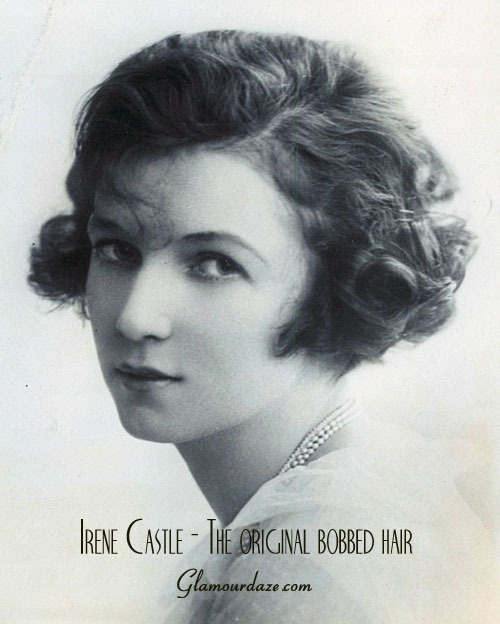 Actress Irene Castle cut her hair short in 1915 shortly before an operation for appendicitis. She liked it so much she never grew it back. In 1919, American women began following her lead.
Actress Irene Castle cut her hair short in 1915 shortly before an operation for appendicitis. She liked it so much she never grew it back. In 1919, American women began following her lead.
 Newspapers were full of articles about the trend, but since it hadn't yet spread beyond major East Coast cities, critics in the heartland held their criticism. That would not last.
Newspapers were full of articles about the trend, but since it hadn't yet spread beyond major East Coast cities, critics in the heartland held their criticism. That would not last.
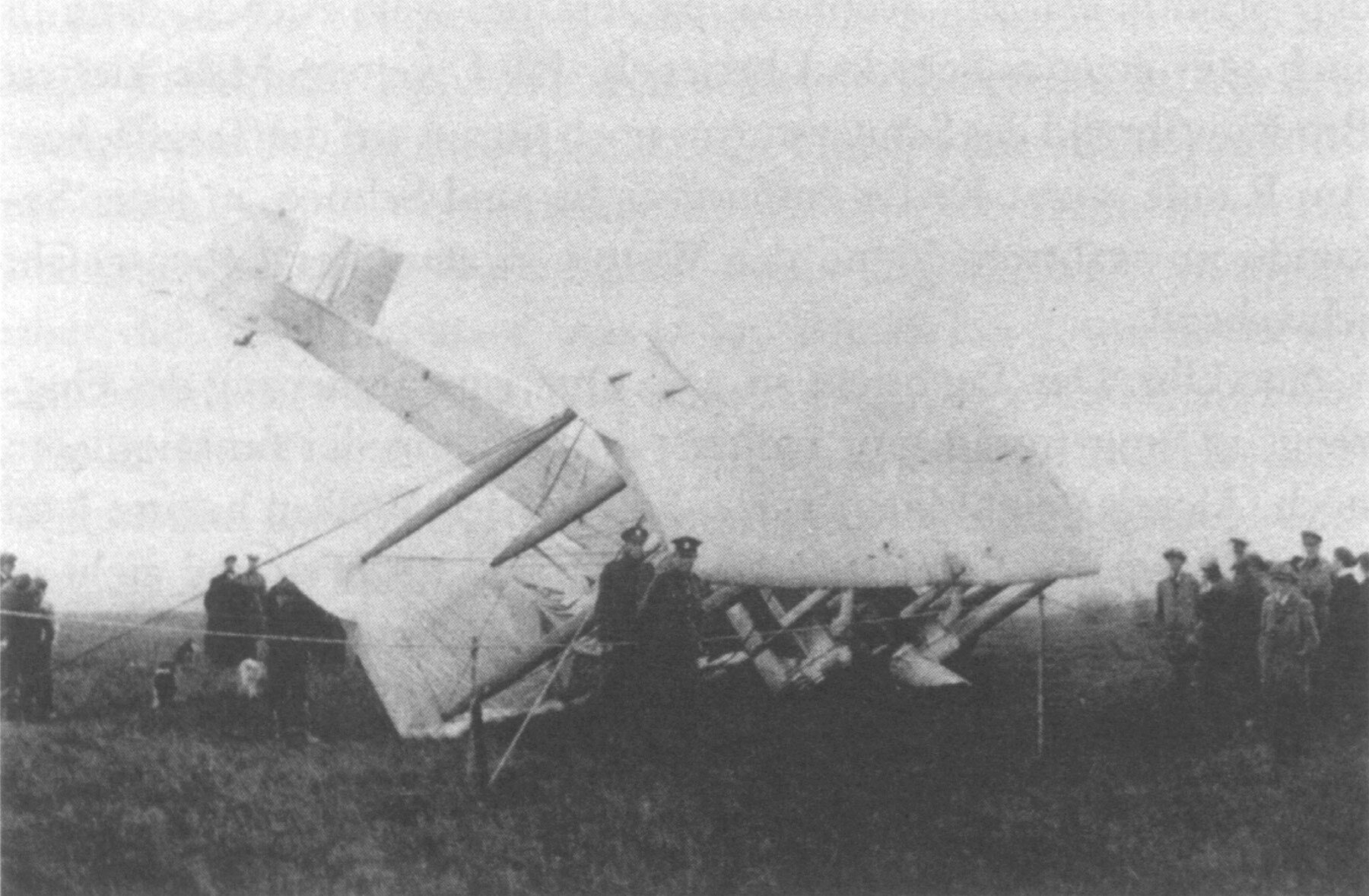 This photo shows Alcock and Brown shortly after landing in Ireland at the conclusion of their record-setting Trans-Atlantic flight. You can see that the plane has tipped nose-first into a bog. Alcock and Brown are the two men in front of the plane in dark hats and coats.
This photo shows Alcock and Brown shortly after landing in Ireland at the conclusion of their record-setting Trans-Atlantic flight. You can see that the plane has tipped nose-first into a bog. Alcock and Brown are the two men in front of the plane in dark hats and coats.
 An estimated 12,000 Native Americans served in World War I, many of them volunteers. They received high praise for their courage acting on behalf of a nation that refused to grant them citizenship, abused their children and kep their tribes in penury.
An estimated 12,000 Native Americans served in World War I, many of them volunteers. They received high praise for their courage acting on behalf of a nation that refused to grant them citizenship, abused their children and kep their tribes in penury.
 Emiliano Zapata was a skilled horseman, an inspirational leader and an unyielding revolutionary. He had no use for political theory and no patience for political compromise. He is still revered by many Mexicans for his unrelenting efforts for the poor and downtrodden.
Emiliano Zapata was a skilled horseman, an inspirational leader and an unyielding revolutionary. He had no use for political theory and no patience for political compromise. He is still revered by many Mexicans for his unrelenting efforts for the poor and downtrodden.
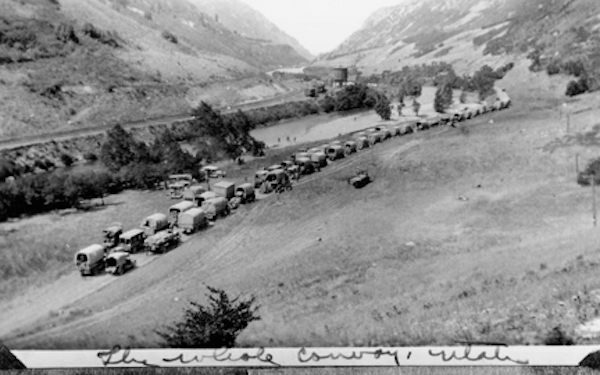 Concerned about the state of America's roads, the U.S. Army sent 80 trucks and cars to cross the country and evaluate the state of the roads. They averaged 6 miles per hour and at one point in the Utah desert had to be rescued by teams of horses. The experience planted a seed in one of the officers on the trip, an idea to create an efficient nationwide highway system.
Concerned about the state of America's roads, the U.S. Army sent 80 trucks and cars to cross the country and evaluate the state of the roads. They averaged 6 miles per hour and at one point in the Utah desert had to be rescued by teams of horses. The experience planted a seed in one of the officers on the trip, an idea to create an efficient nationwide highway system.

Softly as in a morning sunrise- Harry Parry, What is this thing called love- Tommy Dorsey, vocals by Connie Haines, Fine brown frame Nellie Lutcher, Let's play love - Bob Skyles, Beautiful dreamer Archie Lewis, Whisper again that you love me-Al Dexter, Ain't misbehaving - Hutch, Look at 'em doing it- The Original Dixieland Jazz Band(1919), You better watch yourself bub- Nellie Lutcher, The man I love - Sophie Tucker, It don't count - Harry Parry, Tip toe through the tulips with me- Solemn and Gay, Moonlight Waltz, I'm gonna die with a broken heart and my darling Texas cowgirl - Bob Skyles and his Skyrockets.

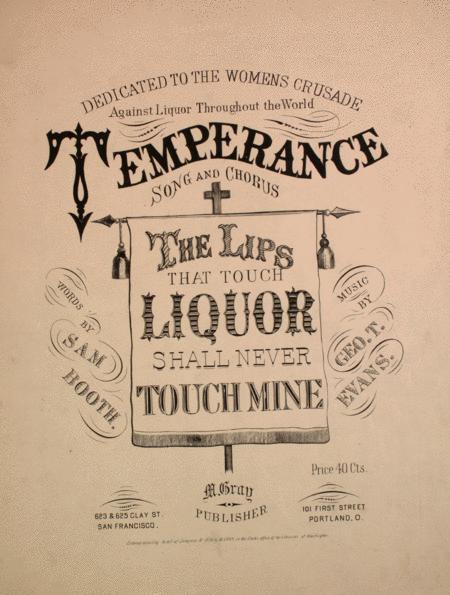 The Temperance Movement began in the 1840s and gained significant momentum through the rest of the century. Women were major leaders in the movement, with many pledging to never let the lips that touch liquor touch theirs. Unfortunately, this seemed to have little effect.
The Temperance Movement began in the 1840s and gained significant momentum through the rest of the century. Women were major leaders in the movement, with many pledging to never let the lips that touch liquor touch theirs. Unfortunately, this seemed to have little effect.
 In the second half of the 19th century, an influx of immigrants from beer-loving countries, including Germany and Ireland, dramatically increased the consumption of beer in the United States. German brewers arrived to meet the demand. The most successful among these brewers was Adolphus Busch. As owner of Anheuser-Busch, he built a massive, vertically integrated operation that controlled every aspect of beer production and distribution, from mining the coal that fueled the brewery to building the refrigerated railcars to deliver the beer to Anheuser-Busch owned saloons.
In the second half of the 19th century, an influx of immigrants from beer-loving countries, including Germany and Ireland, dramatically increased the consumption of beer in the United States. German brewers arrived to meet the demand. The most successful among these brewers was Adolphus Busch. As owner of Anheuser-Busch, he built a massive, vertically integrated operation that controlled every aspect of beer production and distribution, from mining the coal that fueled the brewery to building the refrigerated railcars to deliver the beer to Anheuser-Busch owned saloons.
 Saloons were more than watering holes. They were hubs for the entire community and played important roles in the lives of patrons, especially when those patrons were recent immigrants.
Pictured here is a saloon in Wisconsin. Notice the little boy sitting at the table with his own beer glass. Boys often accompanied their fathers to saloons. Women and girls, however, were not welcome, and a woman who stepped in a saloon ruined her reputation.
Saloons were more than watering holes. They were hubs for the entire community and played important roles in the lives of patrons, especially when those patrons were recent immigrants.
Pictured here is a saloon in Wisconsin. Notice the little boy sitting at the table with his own beer glass. Boys often accompanied their fathers to saloons. Women and girls, however, were not welcome, and a woman who stepped in a saloon ruined her reputation.
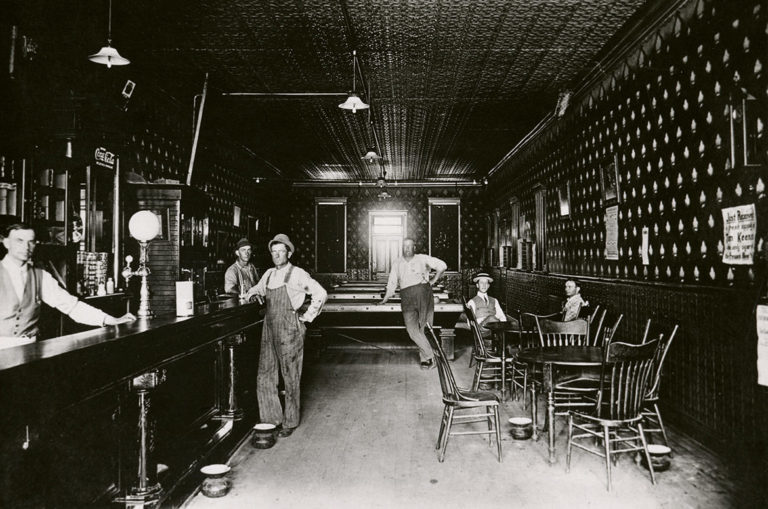 Here's another saloon, this one from Michigan. In a saloon, men could meet friends, participate in local politics, eat a free lunch, take a bath, find a job, get his mail and pawn his watch.
Here's another saloon, this one from Michigan. In a saloon, men could meet friends, participate in local politics, eat a free lunch, take a bath, find a job, get his mail and pawn his watch.
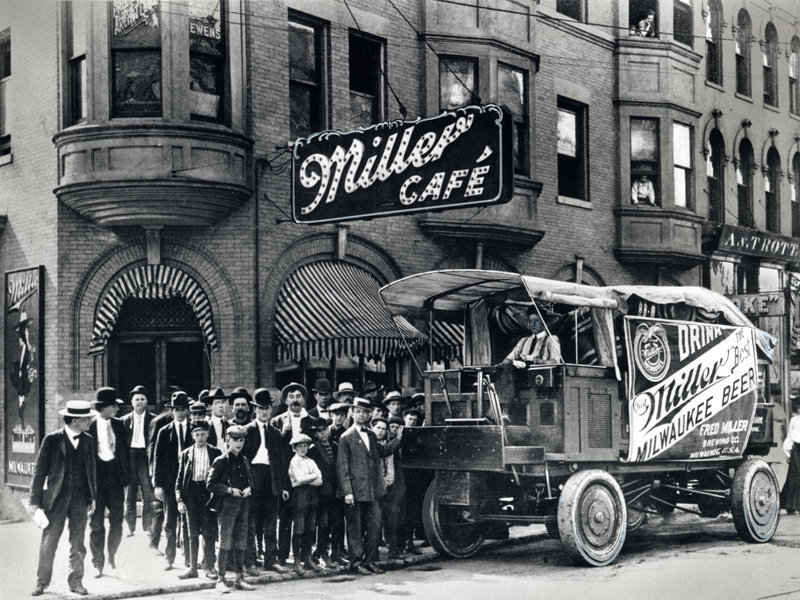 By 1900, most saloons were "tied houses." That is, they were tied to, if not actually owned by, breweries. In exchange for agreeing to sell only one brand of beer, a barkeeper would receive cash for his licensing fees, an inventory of glassware, and the furnishings for the saloon, including the pool tables and the mirrors on the walls.
This photo shows a Miller bar in Chicago.
By 1900, most saloons were "tied houses." That is, they were tied to, if not actually owned by, breweries. In exchange for agreeing to sell only one brand of beer, a barkeeper would receive cash for his licensing fees, an inventory of glassware, and the furnishings for the saloon, including the pool tables and the mirrors on the walls.
This photo shows a Miller bar in Chicago.
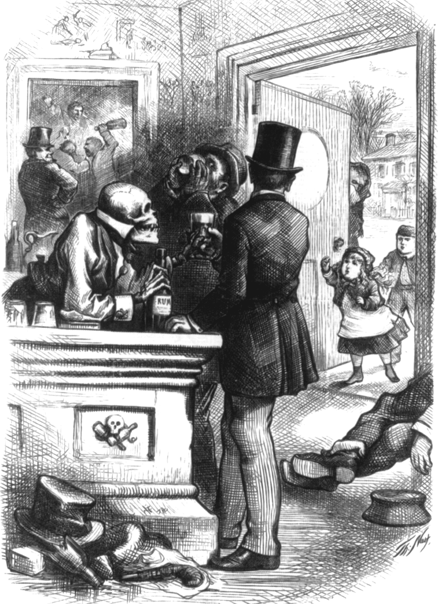 Temperance activists believed saloons were evil through and through. This cartoon, probably from the mid- to late-19th century, shows children desperately calling for the father, who stands in his natty coat and top hat at the bar. The bartender is a grinning skull, and another skull atop crossed bottles decorates in the bar. In the background, a brawl has broken out. Clearly, nothing good happens at a saloon!
Temperance activists believed saloons were evil through and through. This cartoon, probably from the mid- to late-19th century, shows children desperately calling for the father, who stands in his natty coat and top hat at the bar. The bartender is a grinning skull, and another skull atop crossed bottles decorates in the bar. In the background, a brawl has broken out. Clearly, nothing good happens at a saloon!
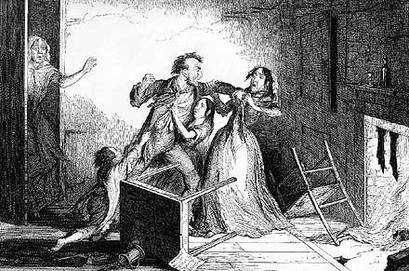 Women's rights activists in particular believed that alcohol was the cause of domestic violence. In this illustration, a drunken man takes a swing at his wife as his children cling to his legs. Many woman suffragists believed that prohibition would stop violence in the home.
Women's rights activists in particular believed that alcohol was the cause of domestic violence. In this illustration, a drunken man takes a swing at his wife as his children cling to his legs. Many woman suffragists believed that prohibition would stop violence in the home.
 The Anti-Saloon League became a force to be reckoned with by organizing all of the anti-alcohol groups. The League was led by Wayne Wheeler, a genial midwesterner that author Daniel Okrent noted resembled Ned Flanders. In fact, Wheeler was a passionate, focused organizer with a backbone of steel who could make or break political careers.
The Anti-Saloon League became a force to be reckoned with by organizing all of the anti-alcohol groups. The League was led by Wayne Wheeler, a genial midwesterner that author Daniel Okrent noted resembled Ned Flanders. In fact, Wheeler was a passionate, focused organizer with a backbone of steel who could make or break political careers.
 Breweries tried reframe beer as a health-giving, nourishing beverage. The Saskatoon Brewing Company tried to sell their beer as "liquid bread."
Breweries tried reframe beer as a health-giving, nourishing beverage. The Saskatoon Brewing Company tried to sell their beer as "liquid bread."
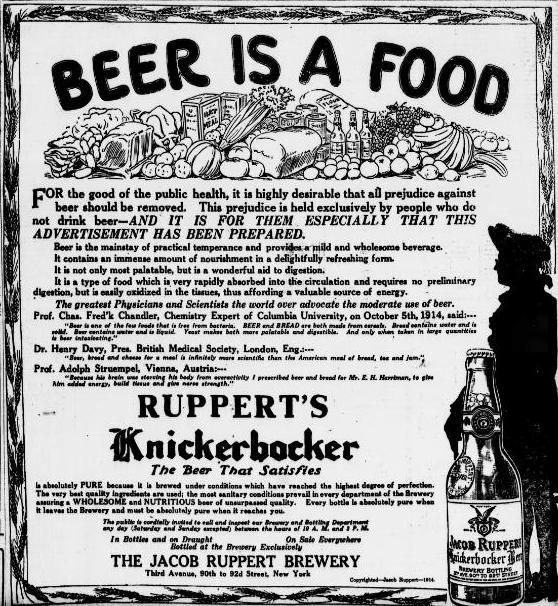 Knickerbocker Beer ran ads declaring "Beer is Food" and claiming that beer was not only "a wonderful aid to digestion" and a "valuable source of energy" but also "a mainstay of practical temperance."
Knickerbocker Beer ran ads declaring "Beer is Food" and claiming that beer was not only "a wonderful aid to digestion" and a "valuable source of energy" but also "a mainstay of practical temperance."
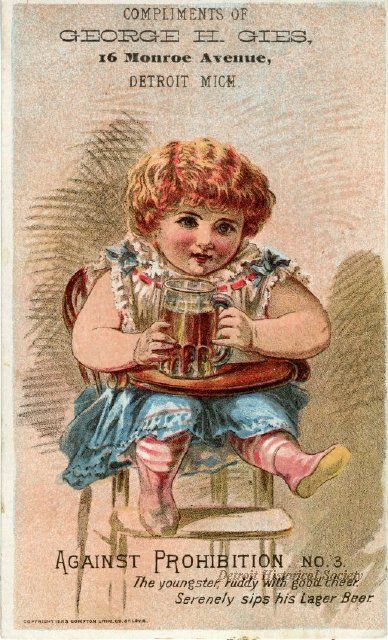 An Anti-Prohibition coalition produced this ad, showing a fat and happy baby drinking a stein of beer. No one was convinced by any of these campaigns.
An Anti-Prohibition coalition produced this ad, showing a fat and happy baby drinking a stein of beer. No one was convinced by any of these campaigns.
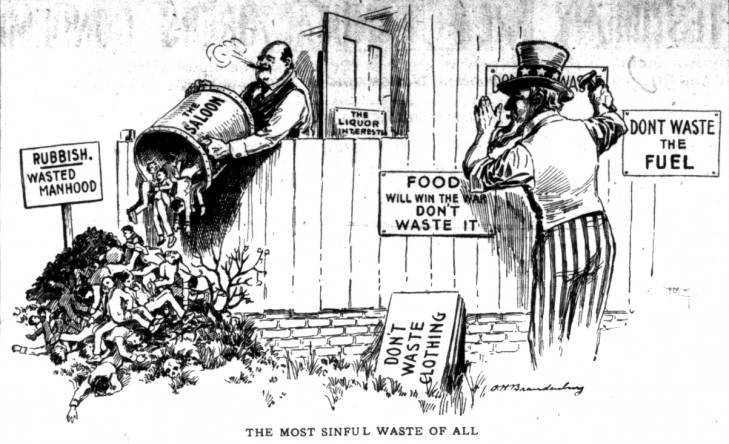 Once the United States entered World War I, a new argument began to be made against the alcohol industry: it wasted food and fuel. Americans were called upon to save food for the military, as well as for the British, French and Belgians. The Anti-Saloon League argued that the alcohol industry wasted tons of food and fuel.
In this cartoon, Uncle Sam puts up posters calling to save food and fuel while the saloon tosses out barrels not only of goods but also of "wasted manhood."
Once the United States entered World War I, a new argument began to be made against the alcohol industry: it wasted food and fuel. Americans were called upon to save food for the military, as well as for the British, French and Belgians. The Anti-Saloon League argued that the alcohol industry wasted tons of food and fuel.
In this cartoon, Uncle Sam puts up posters calling to save food and fuel while the saloon tosses out barrels not only of goods but also of "wasted manhood."
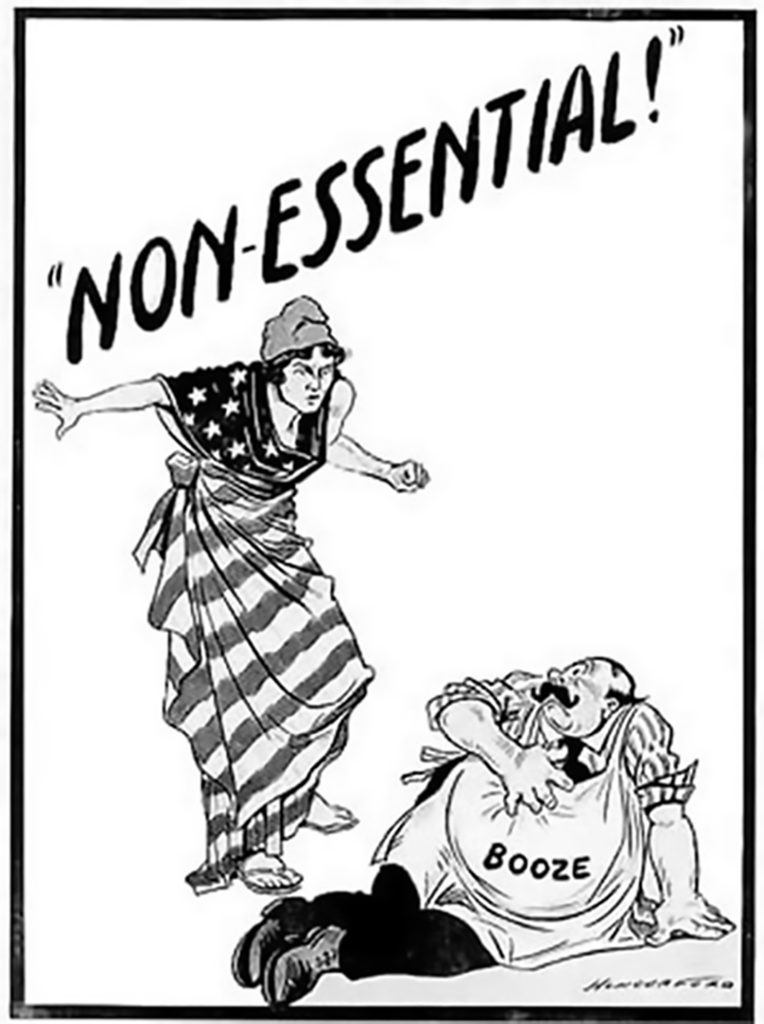 "Non-essential" was an insult during the war--anything non-essential to winning the war was useless and to be despised. Here a woman clad in an American flag hurls the word at a fat man identified as "Booze."
"Non-essential" was an insult during the war--anything non-essential to winning the war was useless and to be despised. Here a woman clad in an American flag hurls the word at a fat man identified as "Booze."
 In late 1917, riding the wave of anti-alcohol sentiment, the Dry alliance pushed the 18th Amendment through Congress. It went to the states for ratification.
The Anti-Saloon League coordinated the ratification fight with an attack on the United States Brewers Association and an immigrant association it had long backed, the German American Alliance. The League convinced the Senate, and the American people, that the Alliance and the Brewers were under the control of the Kaiser and enemies of America.
In late 1917, riding the wave of anti-alcohol sentiment, the Dry alliance pushed the 18th Amendment through Congress. It went to the states for ratification.
The Anti-Saloon League coordinated the ratification fight with an attack on the United States Brewers Association and an immigrant association it had long backed, the German American Alliance. The League convinced the Senate, and the American people, that the Alliance and the Brewers were under the control of the Kaiser and enemies of America.
 A Senate sub-committee investigated the charges and seemed to prove all sorts of underhanded dealings. It's true that the Brewers had played dirty by bribing politicians and and paying off newspapers, but their aim had been to stop Prohibition, not lost the war to Germany.
A Senate sub-committee investigated the charges and seemed to prove all sorts of underhanded dealings. It's true that the Brewers had played dirty by bribing politicians and and paying off newspapers, but their aim had been to stop Prohibition, not lost the war to Germany.
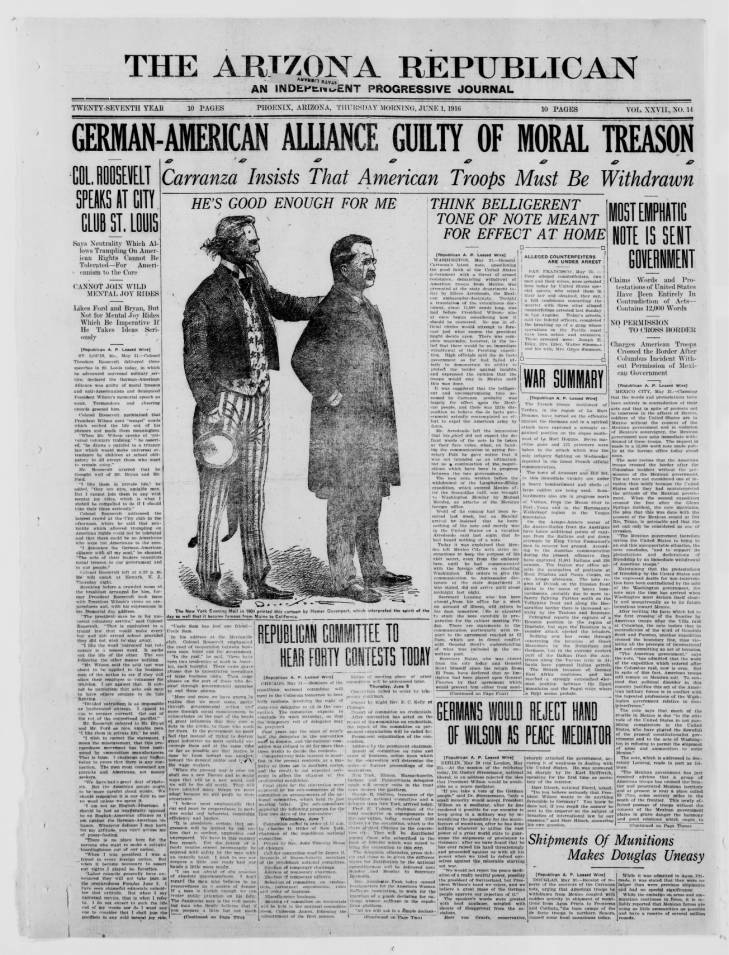 No charges ever came out of the subcommittee, but it didn't matter. Americans had found the Alliance and the Brewers guilty in the court of public opinion.
No charges ever came out of the subcommittee, but it didn't matter. Americans had found the Alliance and the Brewers guilty in the court of public opinion.
 In this heady atmosphere, the 18th Amendment was rapidly ratified by all but two states on January 17, 1919. In one year, the amendment would go into effect.
In this heady atmosphere, the 18th Amendment was rapidly ratified by all but two states on January 17, 1919. In one year, the amendment would go into effect.
 The most important job for Congress was to pass legislation defining the terms of the 18th Amendment (what constituted an "intoxicating beverage"?) and creating enforcement mechanisms. The man responsible for the bill was Andrew John Volstead, a man so strait-laced he did yardwork in a coat and tie.
The most important job for Congress was to pass legislation defining the terms of the 18th Amendment (what constituted an "intoxicating beverage"?) and creating enforcement mechanisms. The man responsible for the bill was Andrew John Volstead, a man so strait-laced he did yardwork in a coat and tie.
 Volstead's bill passed in October, but then Wilson vetoed it. Americans were shocked. Wilson had never even committed on Prohibition. Congress, fed up with the president after the long and ugly League of Nations fight, overturned the veto two hours later.
Volstead's bill passed in October, but then Wilson vetoed it. Americans were shocked. Wilson had never even committed on Prohibition. Congress, fed up with the president after the long and ugly League of Nations fight, overturned the veto two hours later.
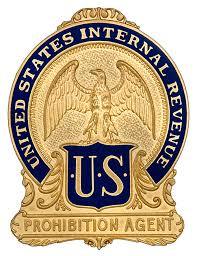 The Volstead Act called for the creation of a new Prohibition Unit to stamp out illegal alcohol. But the agents were to be paid measly salaries and the majority lacked any law enforcement training or experience. They were, inevitably, corrupt.
The Volstead Act called for the creation of a new Prohibition Unit to stamp out illegal alcohol. But the agents were to be paid measly salaries and the majority lacked any law enforcement training or experience. They were, inevitably, corrupt.
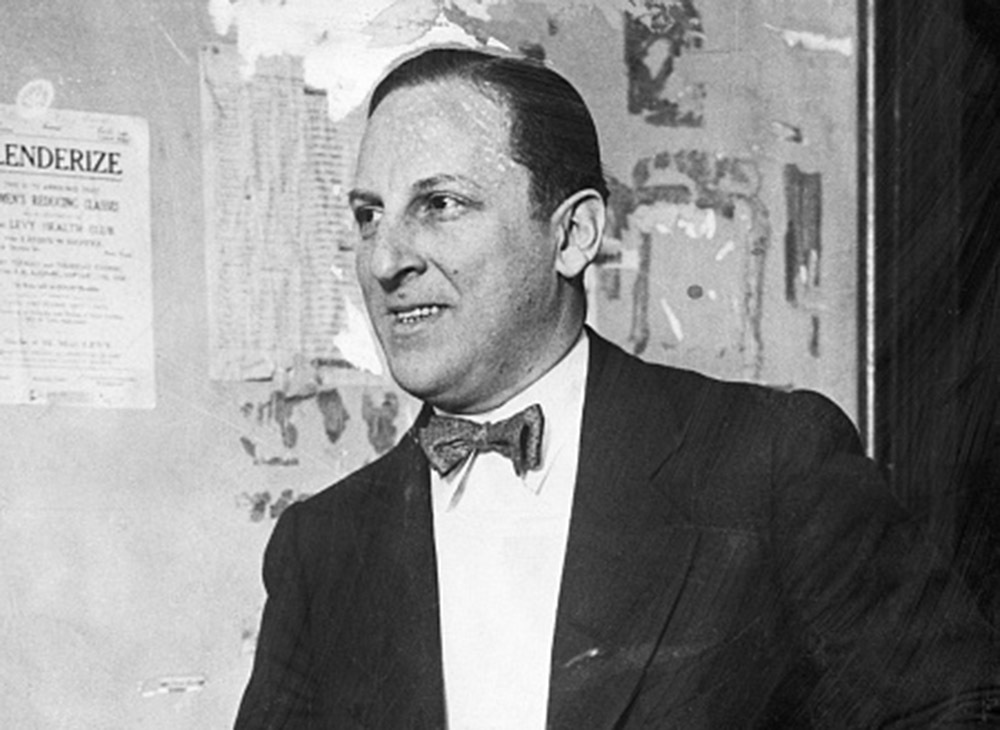 Criminals also spent 1919 getting ready for Prohibition. Arnold Rothstein, who providing the funds to throw the 1919 World Series, organized a comprehensive smuggling operation to bring liquor from Europe to the United States. He was only one of many crooks and bootleggers getting their ducks in a row for the following year.
Criminals also spent 1919 getting ready for Prohibition. Arnold Rothstein, who providing the funds to throw the 1919 World Series, organized a comprehensive smuggling operation to bring liquor from Europe to the United States. He was only one of many crooks and bootleggers getting their ducks in a row for the following year.
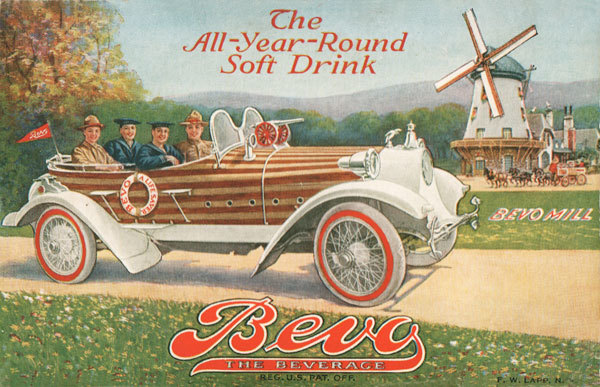 Brewers had to find a way to make do. Anheuser-Busch sold malt extract, brewer's yeast, and Bevo, a soft drink. It was not a success.
Brewers had to find a way to make do. Anheuser-Busch sold malt extract, brewer's yeast, and Bevo, a soft drink. It was not a success.
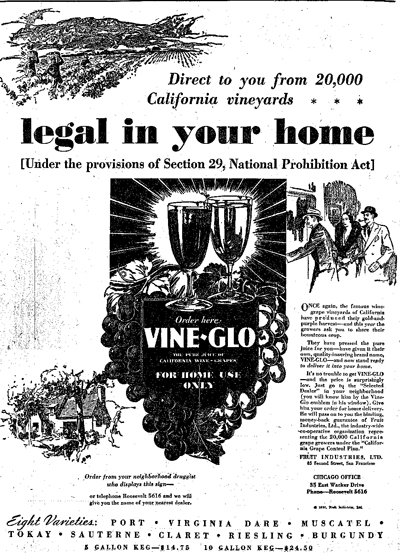 Companies also found creative ways to exploit loopholes in the Volstead Act. It was perfectly legal, for example, for wineries to condense grape juice down to semi-solid block known as a "grape brick." These bricks were sold along with careful instructions on how not to mix the juice with water to make wine. You wouldn't want people to accidentally break the law, now would you? Homebrew kits came with similar instructions.
Companies also found creative ways to exploit loopholes in the Volstead Act. It was perfectly legal, for example, for wineries to condense grape juice down to semi-solid block known as a "grape brick." These bricks were sold along with careful instructions on how not to mix the juice with water to make wine. You wouldn't want people to accidentally break the law, now would you? Homebrew kits came with similar instructions.
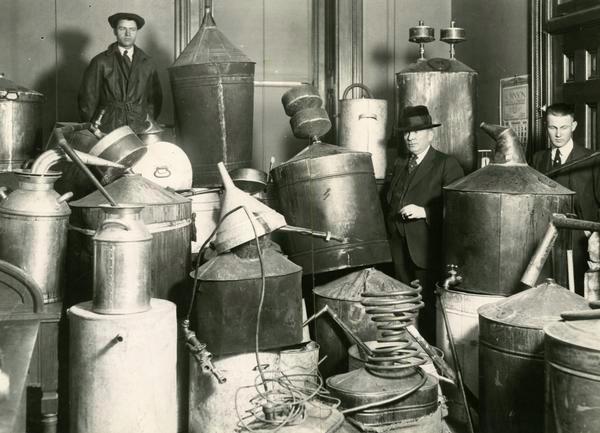 Moonshine operations sprang up across the country, with different regions developing their own recipes and reputations for quality or lack thereof. Pictured here are stills seized from moonshiners in Colorado. The metal was sold for scrap. It's likely by the time this photo was taken, the moonshiners had already begun their next batch.
Moonshine operations sprang up across the country, with different regions developing their own recipes and reputations for quality or lack thereof. Pictured here are stills seized from moonshiners in Colorado. The metal was sold for scrap. It's likely by the time this photo was taken, the moonshiners had already begun their next batch.
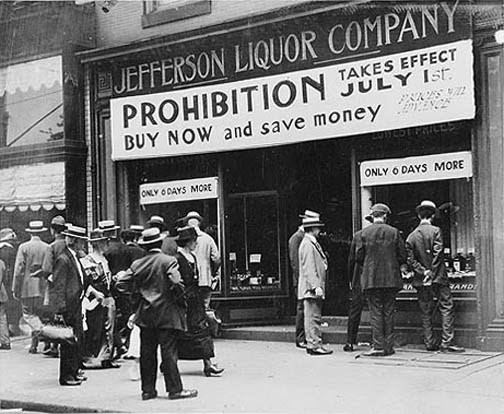 As the clock wound down to January 17, liquor stores began selling out their inventory. People stockpiled as much as they could afford--since, as far as they knew, alcohol would be illegal forever in the United States.
As the clock wound down to January 17, liquor stores began selling out their inventory. People stockpiled as much as they could afford--since, as far as they knew, alcohol would be illegal forever in the United States.
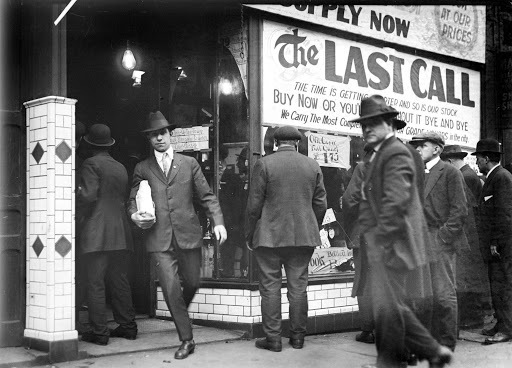 Here a line extends out of the store as men line up to buy a last few bottles. It was going to be a long, dry time.
Here a line extends out of the store as men line up to buy a last few bottles. It was going to be a long, dry time.

Jackie & Dunlap talk to old friend Guy Lancaster, co-author of Blood In Their Eyes: The Elaine Massacre of 1919, about the little-known Arkansas atrocity and the startling similarities between then and now.
Plus: Trump at the bean desk, Walmart requires masks, Parscale out as campaign manager, Sessions loses Alabama, Chuck Woolery, Roger Stone, Trump vs. numbers, McEnany vs. science, Everybody Hates Fauci, Cuomo on TikTok, boats, bikers, Mary Trump.
Order Blood In Their Eyes: https://www.uapress.com/product/blood-in-their-eyes-2/
Encyclopedia of Arkansas on Elaine Massacre: https://encyclopediaofarkansas.net/entries/elaine-massacre-of-1919-1102/
Encyclopedia of Arkanasas on White Lightning:
https://encyclopediaofarkansas.net/entries/white-lightning-movie-6865/
An Epistemology of Ignorance by Guy Lancaster: https://robertslibrary.org/blog/an-epistemology-of-ignorance/
Jim Crown and Fascism by Guy Lancaster: https://historynewsnetwork.org/article/174673
The Red State Update Wiki:
https://red-state-update.fandom.com/wiki/Red_State_Update_(Overview)
"The Magic Cowboy" courtesy Seth Timbs:
https://sethtimbs.bandcamp.com/
Red State Update theme "Tasty Sorghum Biscuit" by William Sherry
http://www.patreon.com/redstateupdate

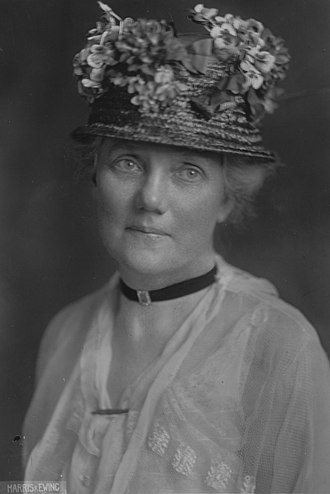 Dora Lewis was the member of prominent Philadelphia family. She was dedicated fighter for the right of women to vote.
Dora Lewis was the member of prominent Philadelphia family. She was dedicated fighter for the right of women to vote.
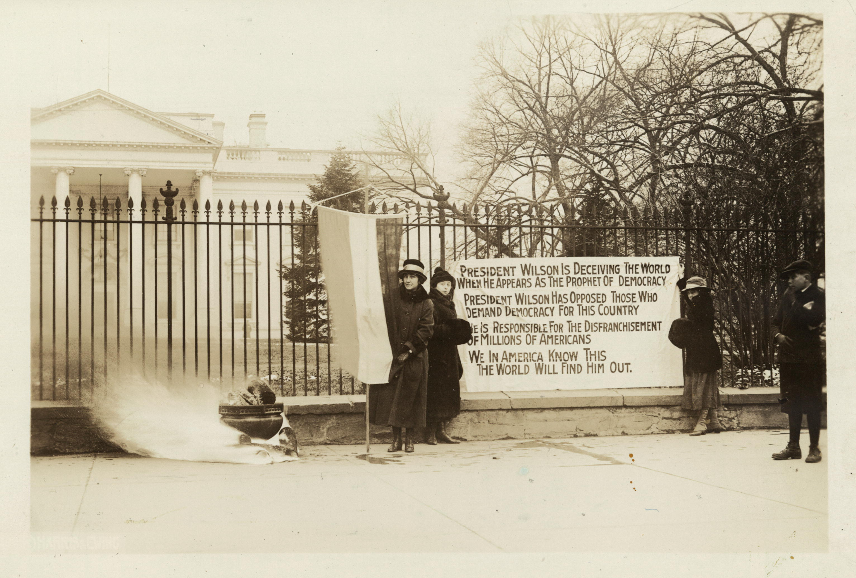 In 1919, Lewis participated in the Watchfires protests, in which suffragists burned the speeches of Woodrow Wilson to reject his hypocricy of speaking about democracy and justice without protecting them for women at home.
In 1919, Lewis participated in the Watchfires protests, in which suffragists burned the speeches of Woodrow Wilson to reject his hypocricy of speaking about democracy and justice without protecting them for women at home.
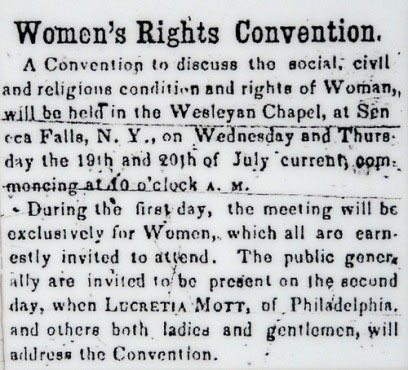 The woman suffrage movement in the United States is usually said to have begun at the Seneca Falls Convention in 1848. The Convention, organized by Elizabeth Cady Stanton and several friends and colleagues, produced a Declaration of Sentiments that called for women to "secure for themselves their right to the elective franchise."
The woman suffrage movement in the United States is usually said to have begun at the Seneca Falls Convention in 1848. The Convention, organized by Elizabeth Cady Stanton and several friends and colleagues, produced a Declaration of Sentiments that called for women to "secure for themselves their right to the elective franchise."
 Elizabeth Cady Stanton (left) and Susan B. Anthony (right) met in 1851 and become close friends and dedicated fighters for votes for women.
Elizabeth Cady Stanton (left) and Susan B. Anthony (right) met in 1851 and become close friends and dedicated fighters for votes for women.
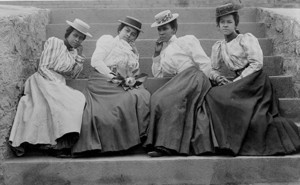 The "New Woman" of the turn of the 19th century was educated, independent, and career-minded. These women were more demanding than previous generations and less concerned about upsetting gender norms.
The "New Woman" of the turn of the 19th century was educated, independent, and career-minded. These women were more demanding than previous generations and less concerned about upsetting gender norms.
 I joked in this episode about New Women and their bicycles, but this was actually an enormous breakthrough for women. For the first time, women had freedom of movement that opened up a world that been narrowly restricted for previous generations.
I joked in this episode about New Women and their bicycles, but this was actually an enormous breakthrough for women. For the first time, women had freedom of movement that opened up a world that been narrowly restricted for previous generations.
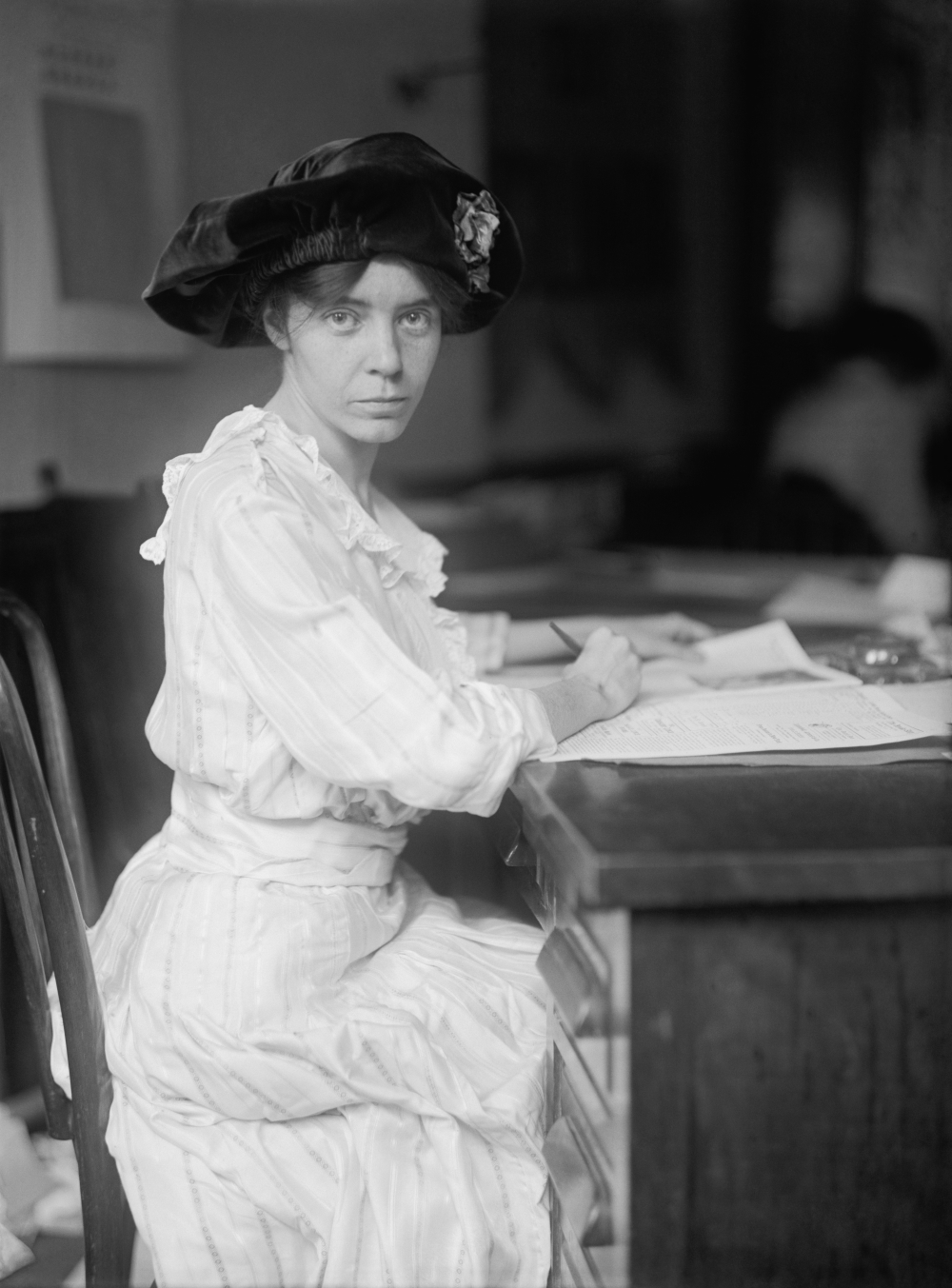 Alice Paul was charismatic, magnetic, and impossible to refuse. She was willing to work herself into the hospital and expected the same level of effort from her friends. (She is also, in this photo, wearing an awesome hat.)
Alice Paul was charismatic, magnetic, and impossible to refuse. She was willing to work herself into the hospital and expected the same level of effort from her friends. (She is also, in this photo, wearing an awesome hat.)
 Alice Paul spent the years between 1907 and 1909 in the United Kingdom, where she joined the radical suffragette movement. She learned the power of protest in England, as well as the power of her own will.
Alice Paul spent the years between 1907 and 1909 in the United Kingdom, where she joined the radical suffragette movement. She learned the power of protest in England, as well as the power of her own will.
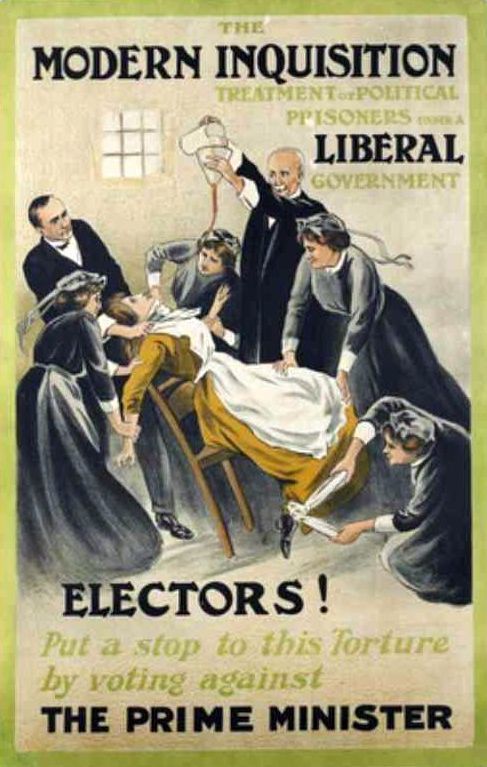 In 1909, Paul went on a hunger strike in prison and was force fed. This was a horrifying, traumatic experience--a fact that the suffragettes didn't hesitate to leverage in their promotional material.
In 1909, Paul went on a hunger strike in prison and was force fed. This was a horrifying, traumatic experience--a fact that the suffragettes didn't hesitate to leverage in their promotional material.
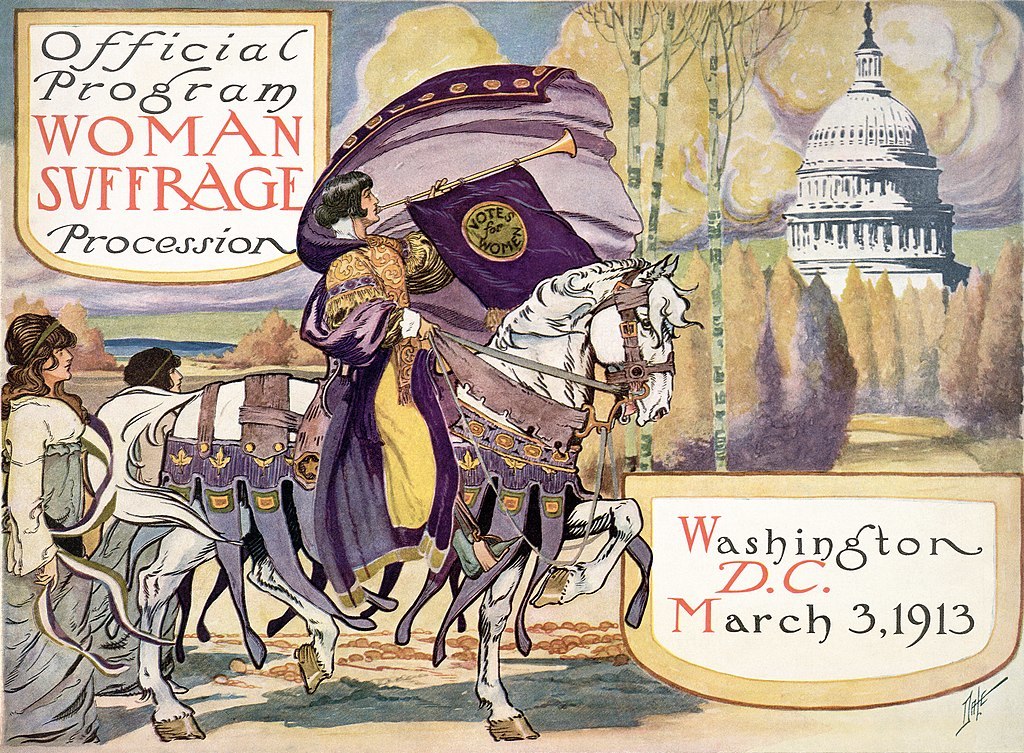 Paul's first major action back in the United States was the Woman Suffrage Procession of 1913. Scheduled the day before Woodrow Wilson's inauguration, it achieved maximum publicity for the cause. This image was used as the cover of the official procession program.
Paul's first major action back in the United States was the Woman Suffrage Procession of 1913. Scheduled the day before Woodrow Wilson's inauguration, it achieved maximum publicity for the cause. This image was used as the cover of the official procession program.
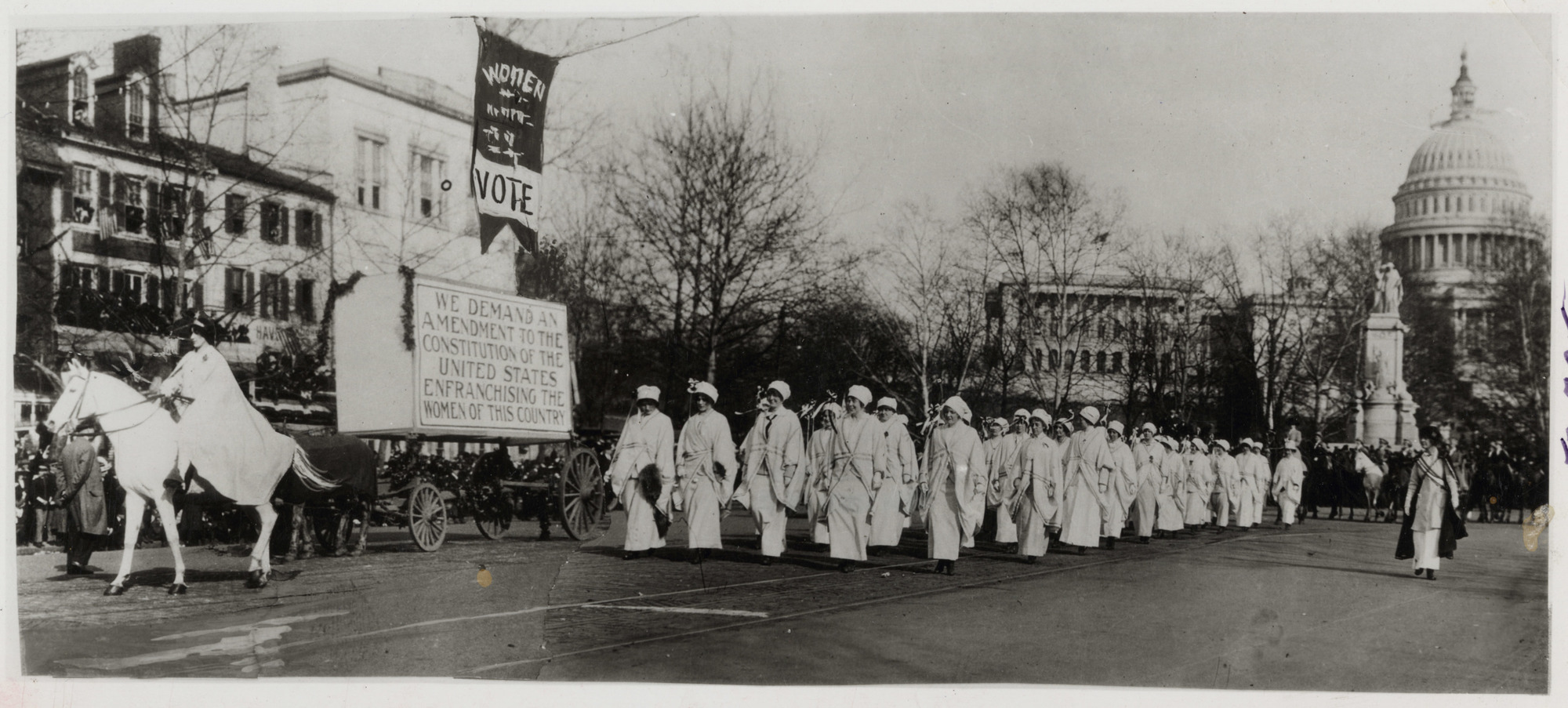 This photo shows the start of the procession, with attorney Inez Mulholland on horseback.
This photo shows the start of the procession, with attorney Inez Mulholland on horseback.
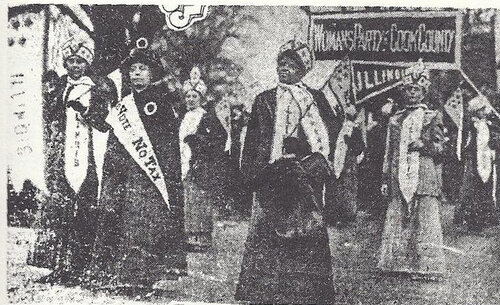 Paul and other organizers intended to segregate African-American marchers to the end of the parade, but Ida B. Wells-Barnett had no intention of being segregated. She joined the Illinois delegation halfway along the route.
Paul and other organizers intended to segregate African-American marchers to the end of the parade, but Ida B. Wells-Barnett had no intention of being segregated. She joined the Illinois delegation halfway along the route.
 Massive crowds viewed the parade. Without adequate police monitoring, the crowd got out of control, spilled into the street, and began harassing the marchers.
Massive crowds viewed the parade. Without adequate police monitoring, the crowd got out of control, spilled into the street, and began harassing the marchers.
 In 1917, the Silent Sentinels began protesting daily at the White House. They carried banners demanding the president take action on women's right to vote.
In 1917, the Silent Sentinels began protesting daily at the White House. They carried banners demanding the president take action on women's right to vote.
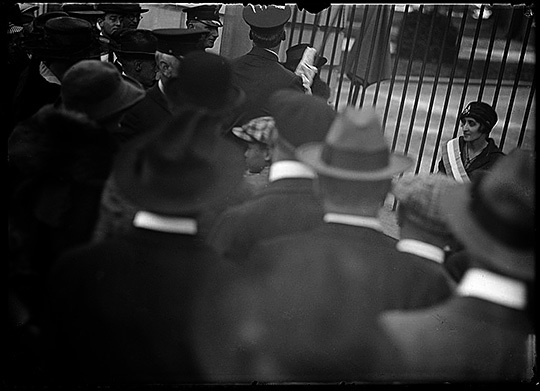 For several months, the protests were peaceful. But Paul began cranking up the tension in the summer, and D.C. police began arresting and detaining the protesters.
For several months, the protests were peaceful. But Paul began cranking up the tension in the summer, and D.C. police began arresting and detaining the protesters.
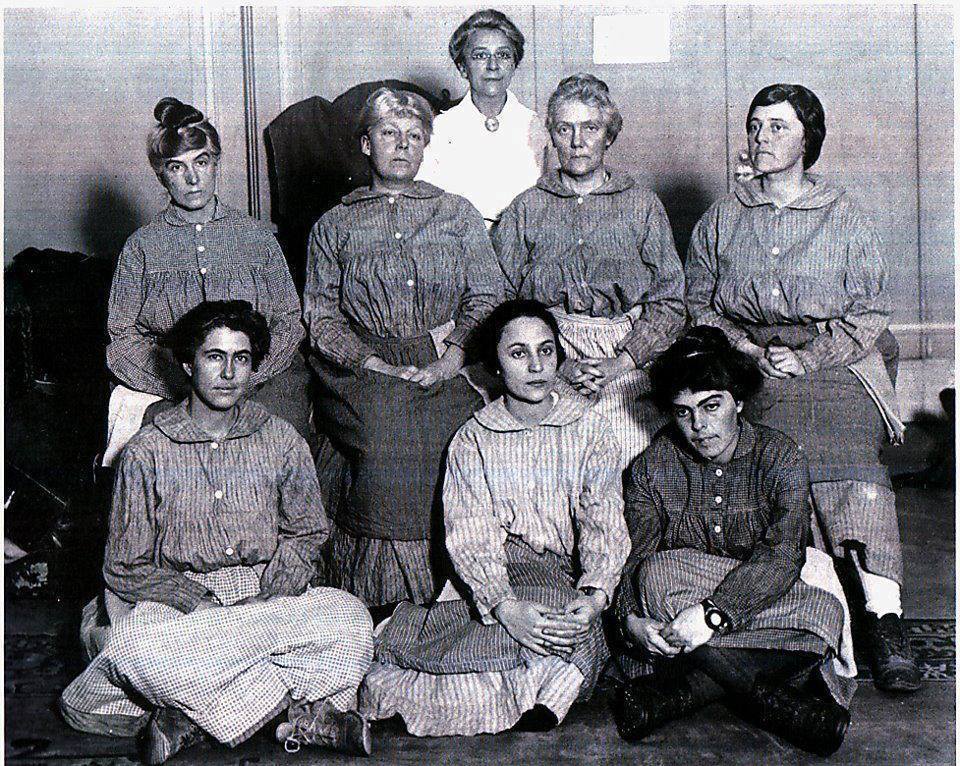 Eventually, suffragists were sentenced to time at Occoquan Workhouse a grim, remote facility. Here several suffragists, including Dora Lewis, pose in their prison uniforms.
Eventually, suffragists were sentenced to time at Occoquan Workhouse a grim, remote facility. Here several suffragists, including Dora Lewis, pose in their prison uniforms.
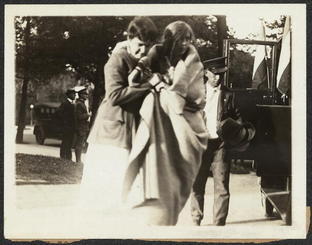 Suffragist prisoners began protests in prison, refusing to wear uniforms or do assigned work. Some, including Alice Paul, went on hunger strikes. Prison guards reacted with increasing violence. Here one of the suffragists has to be helped to a car after a harrowing stay at Occoquan.
Suffragist prisoners began protests in prison, refusing to wear uniforms or do assigned work. Some, including Alice Paul, went on hunger strikes. Prison guards reacted with increasing violence. Here one of the suffragists has to be helped to a car after a harrowing stay at Occoquan.
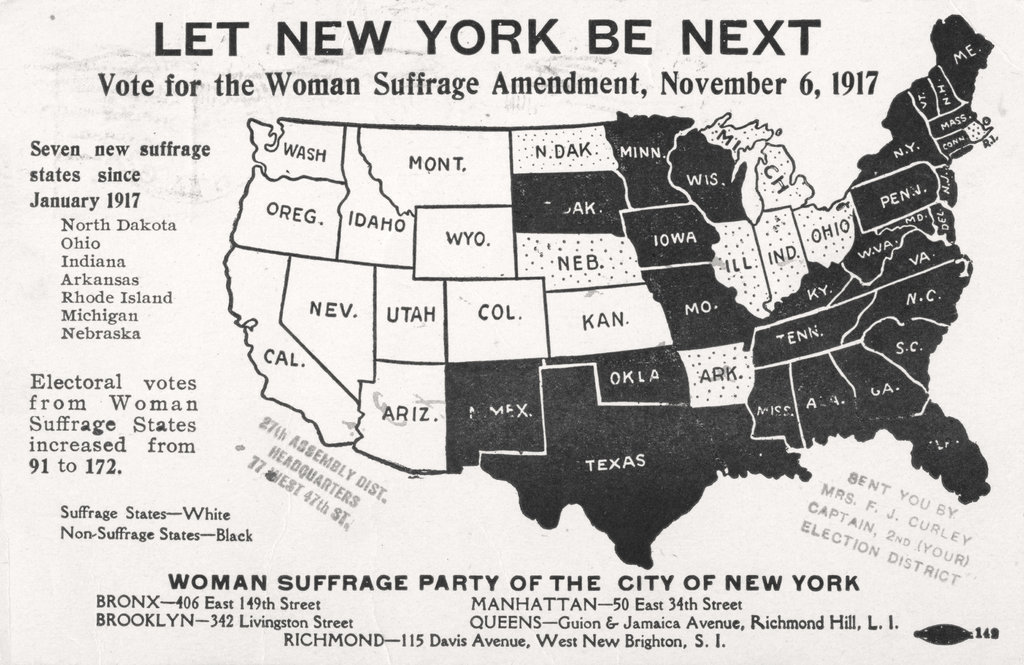 At the same time the members of the NWP were protesting daily at the White House, members of the rival organization NAWSA were conducting a massive campaign for suffrage in New York. They won the vote for 2 million women and reinforced the nationwide conviction that the time had come for a federal amendment.
At the same time the members of the NWP were protesting daily at the White House, members of the rival organization NAWSA were conducting a massive campaign for suffrage in New York. They won the vote for 2 million women and reinforced the nationwide conviction that the time had come for a federal amendment.
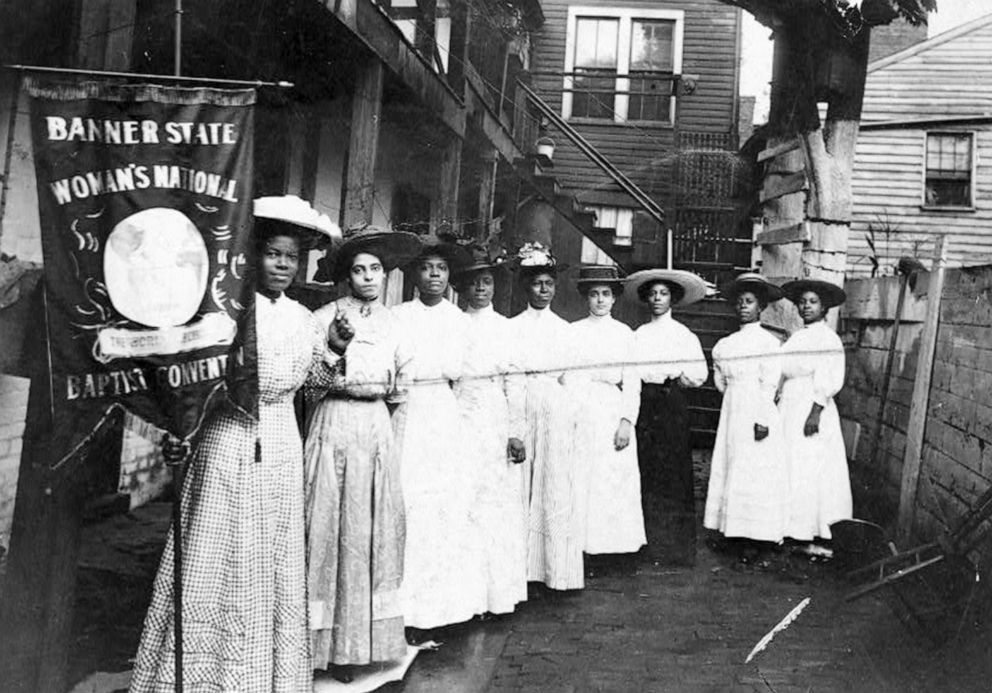 The New York campaign was one of the most inclusive in suffrage history. NAWSA partnered with both the Wage Earner's Suffrage League and the New York City Colored Woman Suffrage Club. African-American suffrage clubs were popular in northern states; this image is of such a group. (I was unable to figure out exactly where these women were from.)
The New York campaign was one of the most inclusive in suffrage history. NAWSA partnered with both the Wage Earner's Suffrage League and the New York City Colored Woman Suffrage Club. African-American suffrage clubs were popular in northern states; this image is of such a group. (I was unable to figure out exactly where these women were from.)
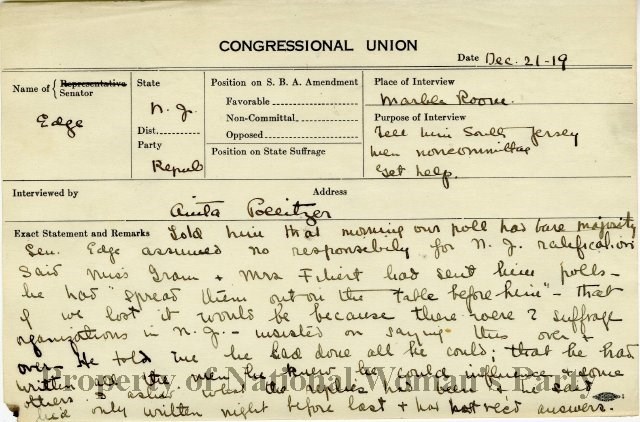 After the House of Representatives passed the federal woman suffrage amendment in 1918, the NWP and NAWSA set aside their differences and worked together to lobby Senators for votes for women. They developed an early form of a database in an index card system that tracked each Senator's friends, memberships, and donors. They also logged notes of each meeting with a Senator, as you can see in this card.
After the House of Representatives passed the federal woman suffrage amendment in 1918, the NWP and NAWSA set aside their differences and worked together to lobby Senators for votes for women. They developed an early form of a database in an index card system that tracked each Senator's friends, memberships, and donors. They also logged notes of each meeting with a Senator, as you can see in this card.
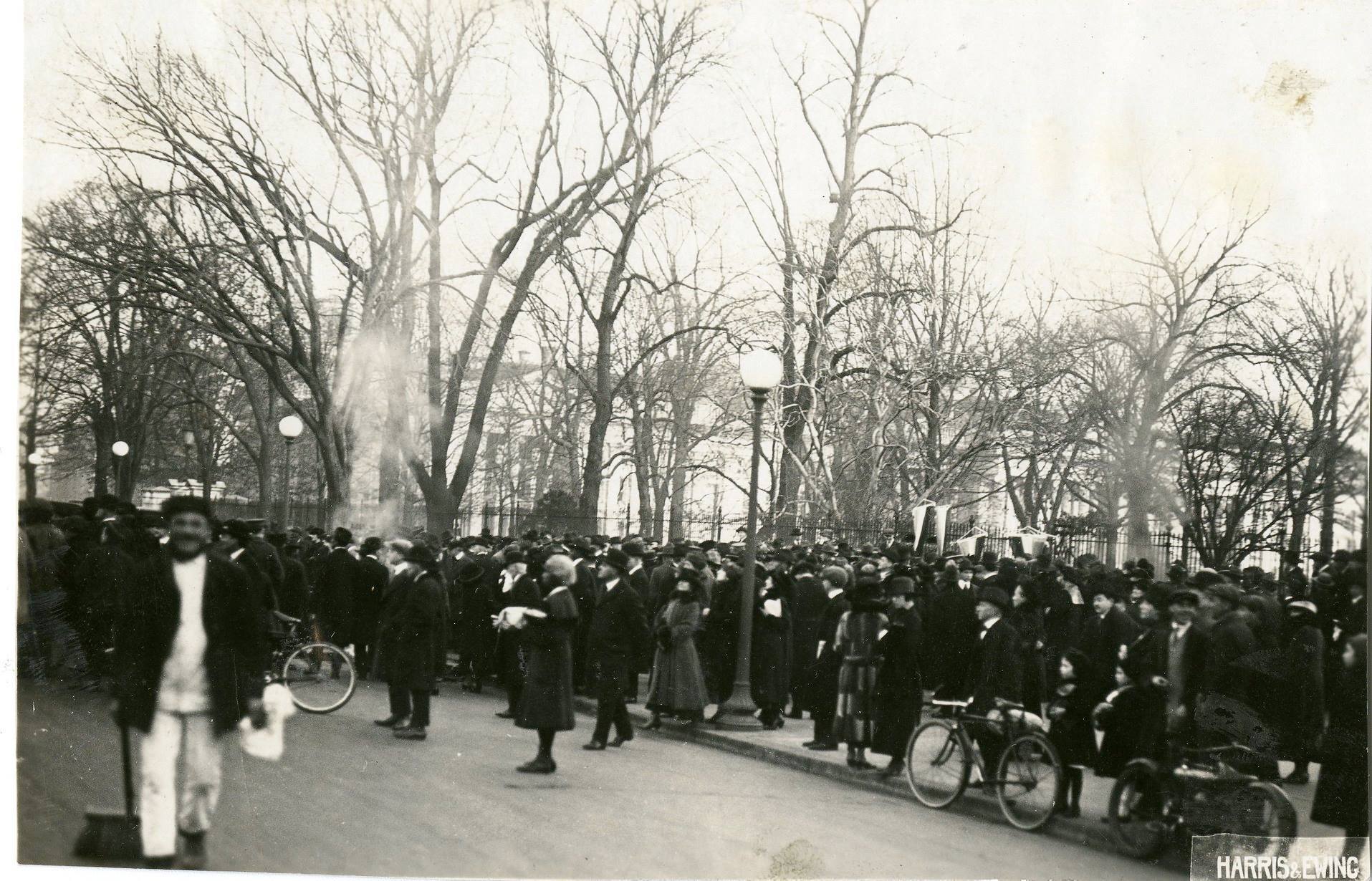 When the amendment failed to pass the Senate in 1918, the NWP began its Watchfires protests burning the president's speeches and even an effigy of the man himself. Crowds inevitably gathered, as seen in this photos, and often the women were arrested.
When the amendment failed to pass the Senate in 1918, the NWP began its Watchfires protests burning the president's speeches and even an effigy of the man himself. Crowds inevitably gathered, as seen in this photos, and often the women were arrested.
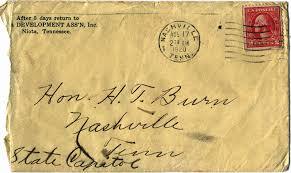 In the summer of 1919, Wilson finally took decisive action, and the House and Senate passed the woman suffrage amendment. The fight moved to the states for ratification. Eventually it all came down to Tennessee the vote of one man, Harry Burn. This is a photo of the letter from Burn's mother that was delivered to him the morning of the vote that made him decide to vote "aye" for suffrage, knowing his constituency would not approve.
In the summer of 1919, Wilson finally took decisive action, and the House and Senate passed the woman suffrage amendment. The fight moved to the states for ratification. Eventually it all came down to Tennessee the vote of one man, Harry Burn. This is a photo of the letter from Burn's mother that was delivered to him the morning of the vote that made him decide to vote "aye" for suffrage, knowing his constituency would not approve.
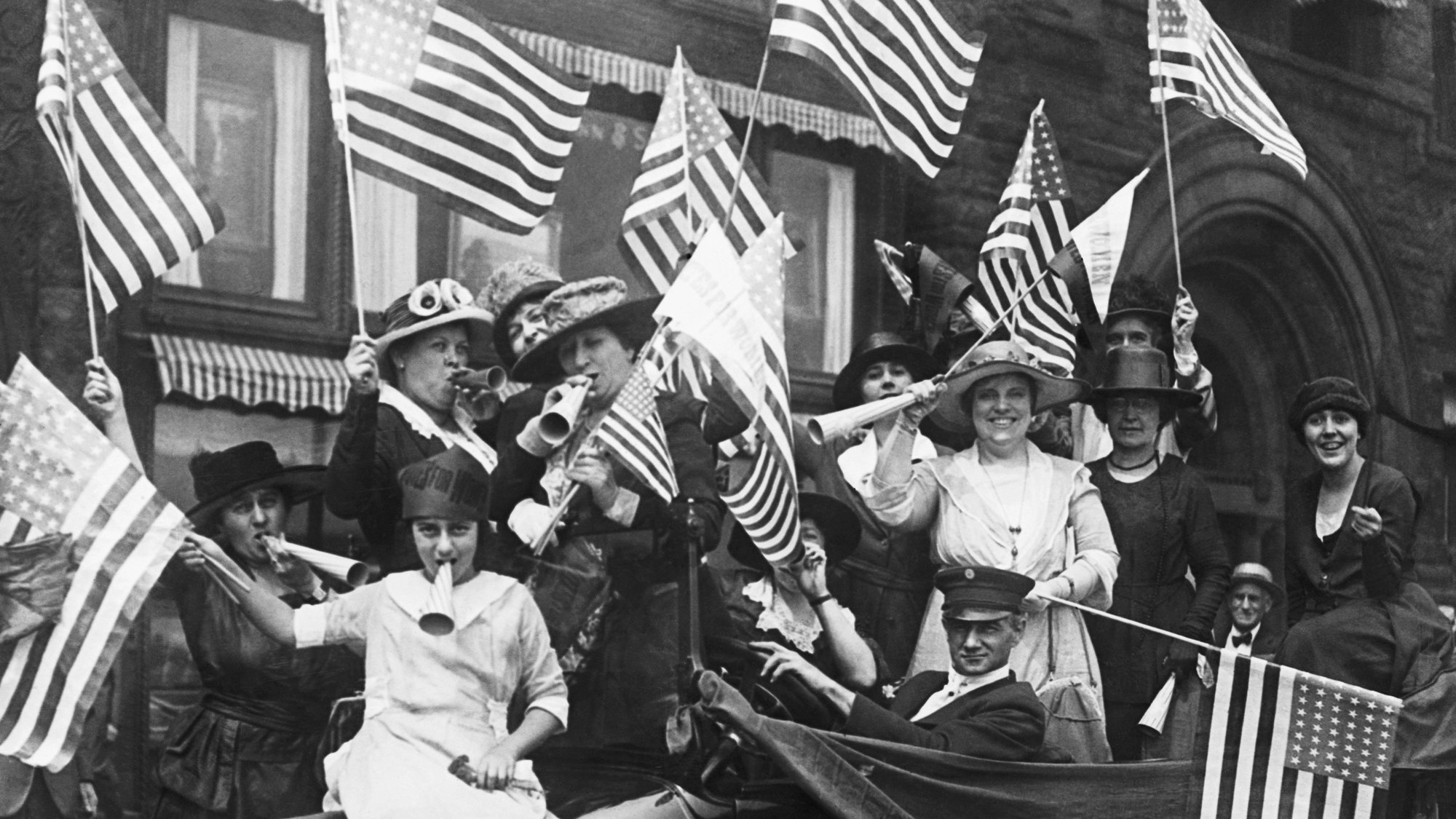 Women across the country celebrated the passage of the 19th Amendment.
Women across the country celebrated the passage of the 19th Amendment.
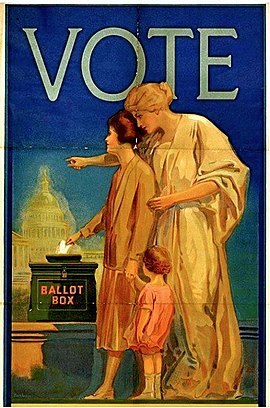 NAWSA evolved into the League of Women Voters and devoted itself to the education of new voters. It continues in this role today.
NAWSA evolved into the League of Women Voters and devoted itself to the education of new voters. It continues in this role today.
 Alice Paul kept the National Woman's Party in operation and began advocating for the Equal Rights Amendment to remove all legal descrimination against woman. Here she is seen in 1969 with one of the original banners from the suffrage fight.
Alice Paul kept the National Woman's Party in operation and began advocating for the Equal Rights Amendment to remove all legal descrimination against woman. Here she is seen in 1969 with one of the original banners from the suffrage fight.

Disaster can be a catalyst for success.
Stay up to date
For any inquiries, please email us at hello@podcastworld.io